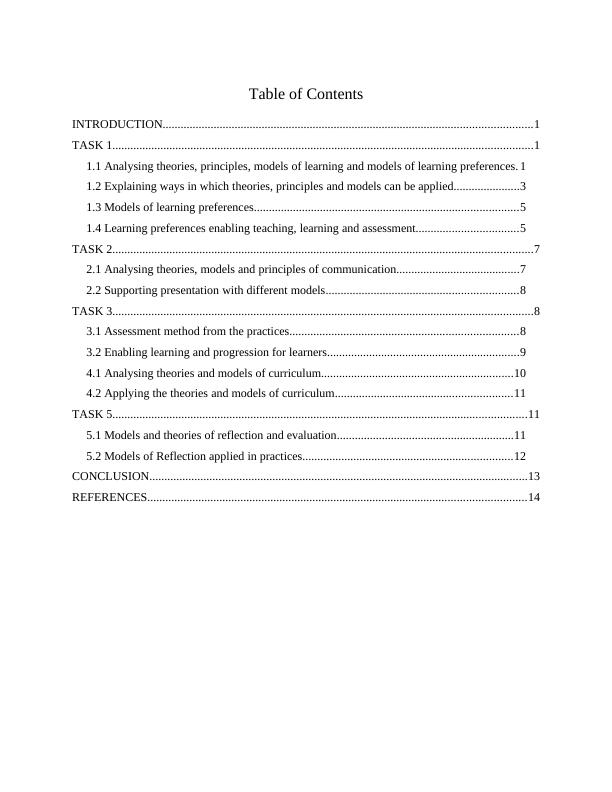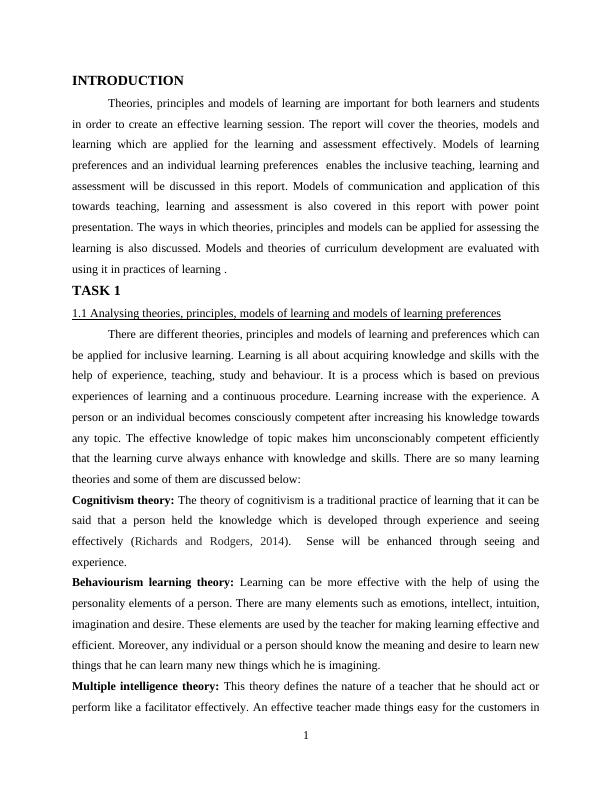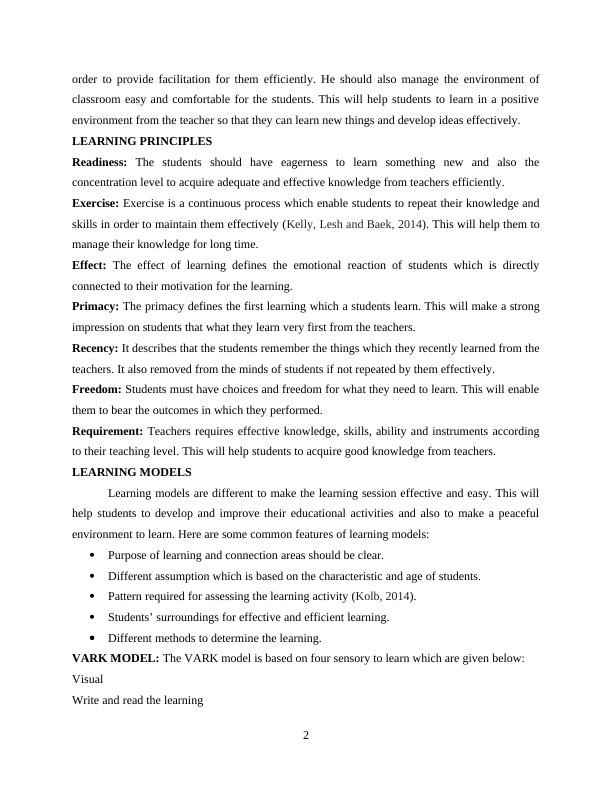Ask a question from expert
Theories Models and Principles in E&T Assignment
17 Pages5730 Words252 Views
Added on 2020-06-04
Theories Models and Principles in E&T Assignment
Added on 2020-06-04
BookmarkShareRelated Documents
THEORIES MODELS ANDPRINCIPLES IN E&T

Table of ContentsINTRODUCTION...........................................................................................................................1TASK 1............................................................................................................................................11.1 Analysing theories, principles, models of learning and models of learning preferences.11.2 Explaining ways in which theories, principles and models can be applied......................31.3 Models of learning preferences........................................................................................51.4 Learning preferences enabling teaching, learning and assessment..................................5TASK 2............................................................................................................................................72.1 Analysing theories, models and principles of communication.........................................72.2 Supporting presentation with different models................................................................8TASK 3............................................................................................................................................83.1 Assessment method from the practices............................................................................83.2 Enabling learning and progression for learners................................................................94.1 Analysing theories and models of curriculum................................................................104.2 Applying the theories and models of curriculum...........................................................11TASK 5..........................................................................................................................................115.1 Models and theories of reflection and evaluation...........................................................115.2 Models of Reflection applied in practices......................................................................12CONCLUSION..............................................................................................................................13REFERENCES..............................................................................................................................14

INTRODUCTIONTheories, principles and models of learning are important for both learners and studentsin order to create an effective learning session. The report will cover the theories, models andlearning which are applied for the learning and assessment effectively. Models of learningpreferences and an individual learning preferences enables the inclusive teaching, learning andassessment will be discussed in this report. Models of communication and application of thistowards teaching, learning and assessment is also covered in this report with power pointpresentation. The ways in which theories, principles and models can be applied for assessing thelearning is also discussed. Models and theories of curriculum development are evaluated withusing it in practices of learning .TASK 11.1 Analysing theories, principles, models of learning and models of learning preferencesThere are different theories, principles and models of learning and preferences which canbe applied for inclusive learning. Learning is all about acquiring knowledge and skills with thehelp of experience, teaching, study and behaviour. It is a process which is based on previousexperiences of learning and a continuous procedure. Learning increase with the experience. Aperson or an individual becomes consciously competent after increasing his knowledge towardsany topic. The effective knowledge of topic makes him unconscionably competent efficientlythat the learning curve always enhance with knowledge and skills. There are so many learningtheories and some of them are discussed below:Cognitivism theory: The theory of cognitivism is a traditional practice of learning that it can besaid that a person held the knowledge which is developed through experience and seeingeffectively (Richards and Rodgers, 2014). Sense will be enhanced through seeing andexperience.Behaviourism learning theory: Learning can be more effective with the help of using thepersonality elements of a person. There are many elements such as emotions, intellect, intuition,imagination and desire. These elements are used by the teacher for making learning effective andefficient. Moreover, any individual or a person should know the meaning and desire to learn newthings that he can learn many new things which he is imagining.Multiple intelligence theory: This theory defines the nature of a teacher that he should act orperform like a facilitator effectively. An effective teacher made things easy for the customers in1

order to provide facilitation for them efficiently. He should also manage the environment ofclassroom easy and comfortable for the students. This will help students to learn in a positiveenvironment from the teacher so that they can learn new things and develop ideas effectively.LEARNING PRINCIPLESReadiness: The students should have eagerness to learn something new and also theconcentration level to acquire adequate and effective knowledge from teachers efficiently.Exercise: Exercise is a continuous process which enable students to repeat their knowledge andskills in order to maintain them effectively (Kelly, Lesh and Baek, 2014). This will help them tomanage their knowledge for long time.Effect: The effect of learning defines the emotional reaction of students which is directlyconnected to their motivation for the learning.Primacy: The primacy defines the first learning which a students learn. This will make a strongimpression on students that what they learn very first from the teachers.Recency: It describes that the students remember the things which they recently learned from theteachers. It also removed from the minds of students if not repeated by them effectively.Freedom: Students must have choices and freedom for what they need to learn. This will enablethem to bear the outcomes in which they performed.Requirement: Teachers requires effective knowledge, skills, ability and instruments accordingto their teaching level. This will help students to acquire good knowledge from teachers.LEARNING MODELSLearning models are different to make the learning session effective and easy. This willhelp students to develop and improve their educational activities and also to make a peacefulenvironment to learn. Here are some common features of learning models:Purpose of learning and connection areas should be clear.Different assumption which is based on the characteristic and age of students.Pattern required for assessing the learning activity (Kolb, 2014).Students’ surroundings for effective and efficient learning.Different methods to determine the learning.VARK MODEL: The VARK model is based on four sensory to learn which are given below:VisualWrite and read the learning2

End of preview
Want to access all the pages? Upload your documents or become a member.
Related Documents
Theories, Principles and Models in Education and Traininglg...
|17
|6826
|388
Theories, Principles and Models in Education and Training - Deskliblg...
|17
|5520
|418
Theories, Principles and Models in Education and Traininglg...
|22
|7919
|323
Theories, Principles and Models in Education and Traininglg...
|20
|4689
|489
Theories, Principles and Models of Teaching, Learning, Assessment and Curriculum Developmentlg...
|16
|3983
|342
Theories, Principles and Models in Education and Traininglg...
|19
|6090
|232